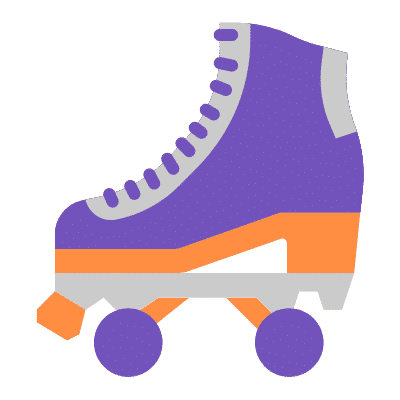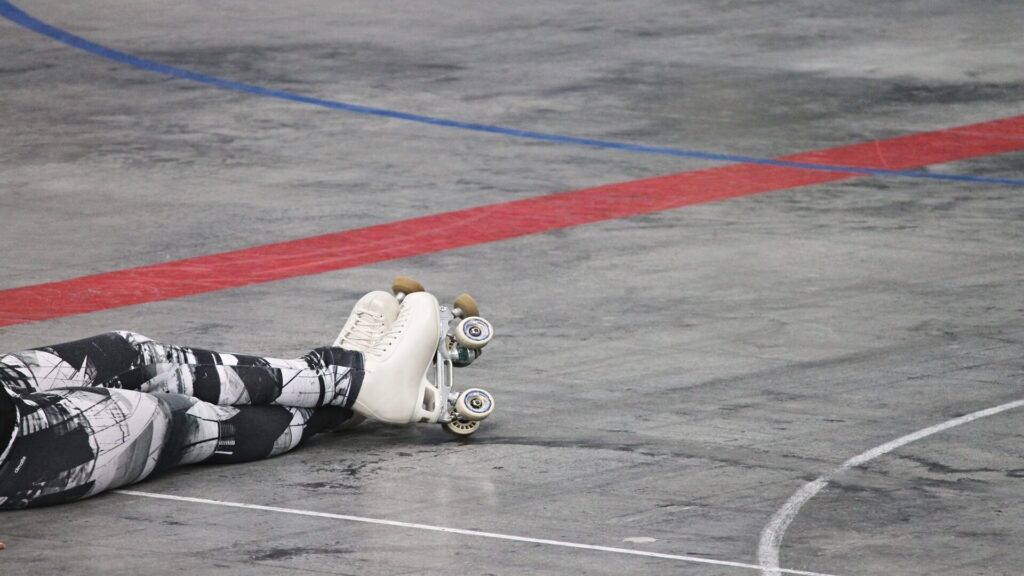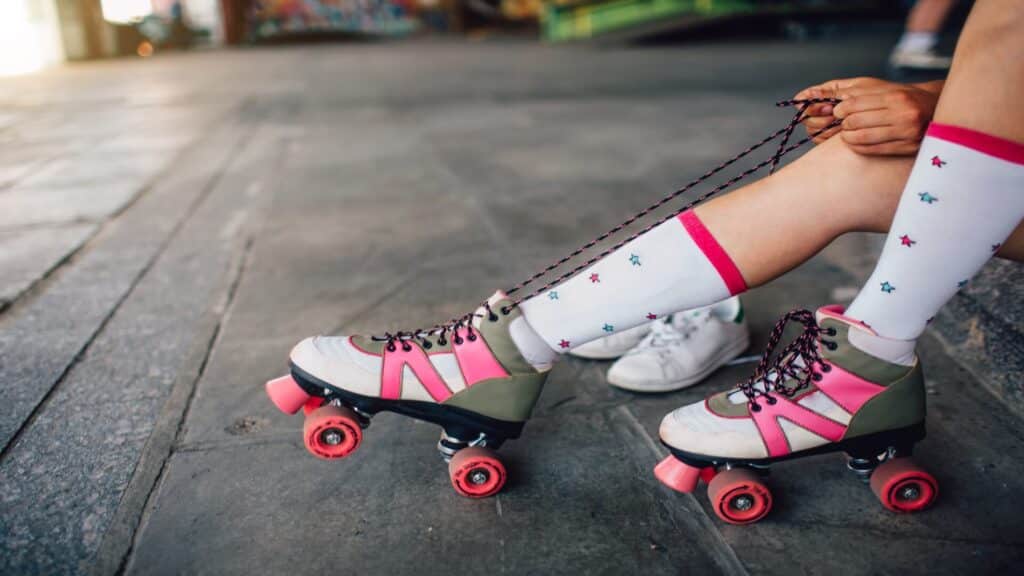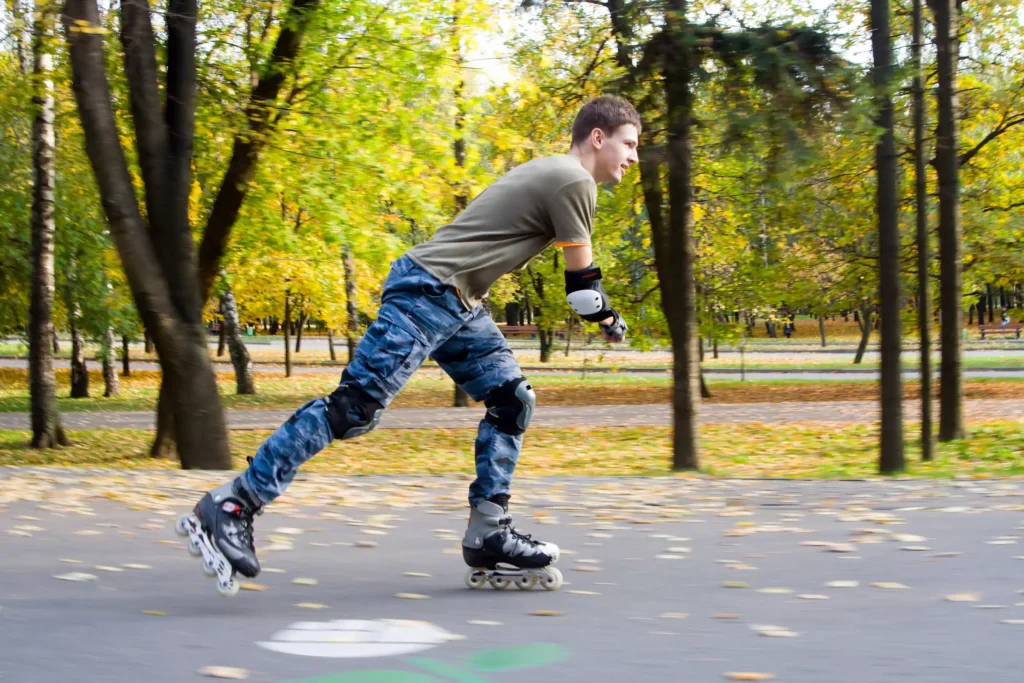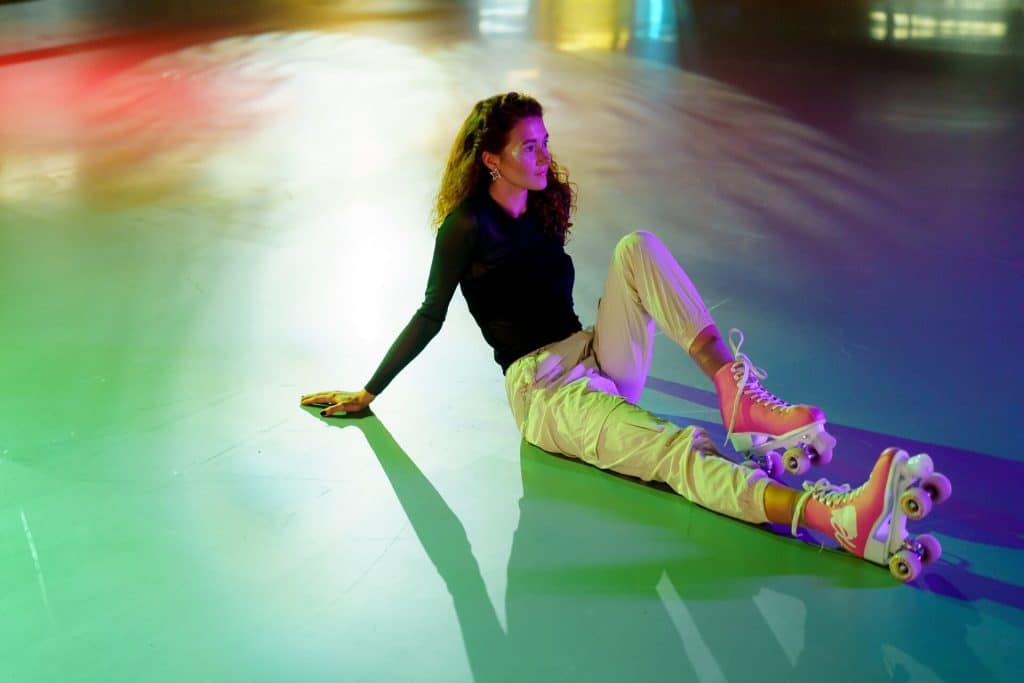Roller skating is not only a lively and enjoyable activity, but it is also an exceptional full-body workout. From your core muscles to your calves, roller skating involves numerous muscle groups in coordinated action. So, let’s delve deeper into the question, what muscles does roller skating work?
Disclaimer: all the information is not a substitute for professional medical advice. Consult a doctor for personalized guidance.
Table of Contents
- Understanding the Mechanism of Roller Skating
- Indoor vs. Outdoor Roller Skating: Muscles Worked
- Core Muscles Worked by Roller Skating
- Lower Body Muscles Engaged by Roller Skating
- Upper Body and Arm Muscles Utilized in Roller Skating
- The Role of Stabilizer Muscles in Roller Skating
- Can You Get Bigger Muscles from Roller Skating?
- Does Roller Skating Work the Whole Body?
- The Cardiovascular Benefits of Roller Skating
- Preventing and Treating Common Roller Skating Injuries
- Roller Skating – A Good Workout for Building Muscles
- Muscles for Advanced Roller Skating Maneuvers
- Final Thoughts
- Frequently Asked Questions
Understanding the Mechanism of Roller Skating
To fully grasp which muscles are worked during roller skating, it’s important to analyze the biomechanics and muscle activation patterns involved in key motions:
Push-Off Phase
As you push off the ground to propel yourself forward, your quadriceps contract concentrically to extend your knee. Your gastrocnemius and soleus also contract concentrically to point your toes, pushing through the wheels. Your glutes and hamstrings work eccentrically to control the movement and prevent hyperextension.
Gliding Phase
During the glide when both feet are on the wheels, your core and back muscles like the erector spinae isometrically contract to maintain an upright posture. Your quadriceps and gluteal muscles also activate isometrically to stabilize your knees and hips. The stabilizing muscles around the ankles and knees reflexively contract to make micro-adjustments and maintain balance.
Turning
Making a turn involves both lower and upper body muscles. Your inner thigh and gluteal muscles contract concentrically to initiate the turn. Your obliques and core muscles toward the direction of the turn and isometrically contract. Your arms and shoulders work to shift weight towards the direction of the turn.
Backward Skating
Skating backward uses muscles differently than forward skating. Your hamstrings and gluteal muscles concentrically contract to push back, with your core and back working isometrically to maintain posture. Your hip flexors open eccentrically to allow the leg extension. Your calves provide the final push through the toes.
Indoor vs. Outdoor Roller Skating: Muscles Worked
While the overall muscle groups activated during roller skating remain the same, there are some subtle differences between indoor and outdoor skating:
- Surface: Outdoor surfaces like pavement and trails are harder and rougher compared to indoor wooden rinks and synthetic floors. This places more emphasis on the core and stabilizer muscles to handle vibrations and maintain balance.
- Maneuvers: Indoor skating allows for more dance-like moves, crossovers, and backward skating that heavily work the core, hips, and upper body. Outdoor skating tends to involve more forward momentum and longer strides engaging the quadriceps.
- Impact: The outdoor environment with varied terrain leads to more impact on the joints and muscles. The calves and shock absorbers like the knee stabilizers adapt to handle this increased impact.
- Cardio: Outdoor skating tends to have a higher cardio workload from overcoming wind resistance and varied terrain. Indoor skating places more focus on muscle toning with choreography.
Core Muscles Worked by Roller Skating
One of the primary beneficiaries of roller skating is the core. Our core muscles form a central link for our upper and lower body, aiding in balance, stability, and movement. They come into play when you are maintaining your balance while gliding on your skates.
The core muscles involved include the rectus abdominis, also known as the abs, which help you maintain an upright position. The obliques, located at the sides of your abdomen, assist in turning and twisting movements. The transverse abdominis, a deep core muscle, is also engaged, helping improve overall stability. Furthermore, roller skating also works the muscles in your lower back, like the erector spinae, which are essential for maintaining an upright posture.
Lower Body Muscles Engaged by Roller Skating
Roller skating is known for its effectiveness in toning the lower torso. The specific muscles worked include:
Quadriceps
These muscles at the front of your thighs are crucial in roller skating. They help control your speed, guide your direction, and maintain balance. They’re most engaged when you extend your leg to push off and when you’re in a slight squat to maintain stability.
Hamstrings
Opposite your quadriceps, your hamstrings are on the back of your thighs. They help bend your knee and extend your hip, essential movements in roller skating. Your hamstrings, in conjunction with your quadriceps, provide the power needed for propulsion.
Calves
Roller skating is a great way to tone your calves. The two primary muscles in this area, the gastrocnemius, and soleus, are heavily engaged when pushing off with your toes and maintaining balance during gliding.
Glutes
Your gluteal muscles, or glutes for short, include the gluteus maximus, medius, and minimus. These muscles are responsible for hip extension, rotation, and abduction. All of these movements are essential for the outward pushing motion and balance maintenance in roller skating.
Upper Body and Arm Muscles Utilized in Roller Skating
The upper body also has its part in roller skating:
Shoulders
When you’re skating, you move your arms for balance, which helps to tone your shoulders. The primary muscle here is the deltoid, which has three sections – anterior, lateral, and posterior, all getting a decent workout.
Back Muscles
The muscles in your back, especially the erector spinal and latissimus dorsi, help maintain your upright posture and contribute to the slight forward lean that’s common in roller skating.
Arm and Forearm Muscles
Your arm muscles, particularly the biceps, and triceps, also get a workout from the swinging action of your arms as you skate. Your forearm muscles, which help with grip and rotation, also get a mild workout, especially if you’re using your hands for balance or during tricks and stunts.
Chest Muscles
The pectoral muscles in your chest, though not as heavily involved, contribute to the arm movements during roller skating. They work in tandem with the back muscles to help maintain balance and posture.
The Role of Stabilizer Muscles in Roller Skating
Besides the larger muscle groups, stabilizer muscles play an essential role in roller skating. These muscles, located around your ankles, knees, and hips, contribute to balance, coordination, and control. They’re particularly engaged when you’re navigating turns or maintaining your balance on one leg during a glide.
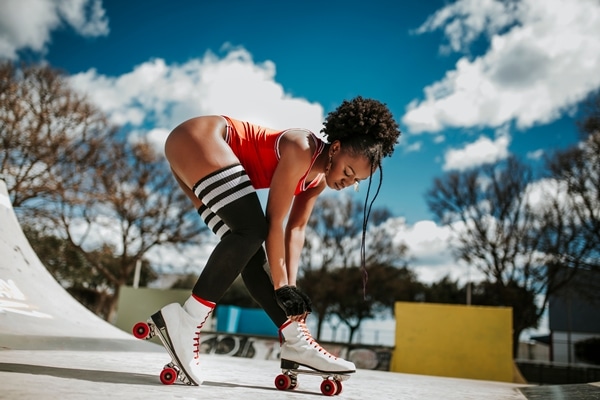
Can You Get Bigger Muscles from Roller Skating?
While roller skating is a great workout that engages various muscle groups, it’s essential to note that it primarily offers toning and strengthening benefits. The activity falls under the category of endurance exercise, given its low resistance and high repetition nature.
If you are looking to significantly increase muscle mass or “get bigger muscles”, incorporating resistance or weight training exercises would be necessary. However, roller skating can definitely help tone your muscles, making them leaner and stronger.
It’s also an excellent complement to a weight-training program, providing cardiovascular benefits and aiding overall fitness.
Does Roller Skating Work the Whole Body?
Absolutely, roller skating does work the whole body. While it’s often seen as a lower-body workout – targeting the quadriceps, hamstrings, glutes, and calf muscles – roller skating also engages the core and upper body muscles.
The core muscles, including the rectus abdominis, transverse abdominis, and lower back muscles, work to maintain balance and stability. The upper body muscles, including the shoulders, arms, and even chest muscles, are involved in maintaining an upright posture and balance.
Also, let’s not forget the role of stabilizer muscles in your ankles, knees, and hips. So, roller skating indeed provides a full-body workout, combining strength training, balance, coordination, and cardio.
Is Roller Skating Good for Your Stomach?
Roller skating is indeed good for your stomach. The sport engages your core muscles, including those in your stomach area, as they work to maintain balance and stability during movement.
Consistent roller skating can strengthen these muscles, which can lead to a more toned appearance. Additionally, as an aerobic exercise, roller skating can contribute to overall fat loss, including in the stomach area, when combined with a healthy diet and consistent exercise routine.
So while it might not directly target your stomach like specific ab exercises would, it’s still a beneficial activity for overall body composition, including your stomach area.
The Cardiovascular Benefits of Roller Skating
Beyond working various muscle groups, roller skating provides excellent cardiovascular conditioning. Here are some of the key cardiovascular benefits:
- Improved Heart Health: The aerobic activity of skating strengthens the heart muscle and boosts heart health. It can help lower blood pressure and cholesterol as well.
- Increased Stamina: Roller skating is considered a vigorous activity, with the potential to burn over 500 calories per hour. Regular skating increases endurance and VO2 max.
- Reduced Disease Risk: Studies show aerobic exercises like skating help reduce the risk of chronic diseases including diabetes, obesity, heart disease, and certain cancers.
- Positive Changes: Consistent skating improves lung capacity, circulation, heart rate recovery, and the efficiency of the heart to pump blood throughout the body.
- Endorphins Release: The feel-good endorphins released during exercise can help elevate mood and manage symptoms of depression and anxiety.
As an aerobic activity that raises heart rate for an extended period, roller skating provides both cardiovascular conditioning and emotional benefits. It’s an effective way to strengthen heart health while also enjoying the mood-lifting endorphin rush.
Preventing and Treating Common Roller Skating Injuries
Roller skating involves repetitive motions that can lead to muscular imbalances and overuse injuries. Here are some tips to help prevent and treat common issues:
- Tight Hip Flexors: Tight hip flexors are common from the constant hip flexion during skating. Stretch the hip flexors daily, and strengthen the glutes and core muscles to balance out the hip area.
- Knee Pain: Knee pain often arises from poor tracking that places stress on the joint. Focus on strengthening quads, glutes, and hips to improve alignment. Use a soft knee brace for support if needed.
- Ankle Instability: Wobbly ankles are frequently caused by weakness in the peroneal muscles. Incorporate ankle eversion, inversion, and alphabet exercises to improve stability.
- Lower Back Pain: A weak core can cause back pain from poor posture. Train core muscles like the transverse abdominis, and work on maintaining an upright posture when skating.
- Wrist Sprains: Falling forward can sprain wrists easily. Wear protective wrist guards and strengthen your wrists by squeezing exercise balls and wrist curls.
Roller Skating – A Good Workout for Building Muscles
Roller skating is a fantastic muscle-building workout on its own, but combining it with targeted off-skate exercises can maximize results. Here is a sample routine:
Warm Up:
5-10 minutes of light skating to raise heart rate and warm up muscles.
Strength Training:
3 sets of 10-15 reps of bodyweight squats, lunges, planks, and push-ups 2-3 times per week to build lower and upper body strength.
Endurance Skating:
45-60 minutes of steady moderate pace outdoor skating 2-3 times per week to build leg and core endurance. Take breaks as needed.
Cool Down Stretching:
5-10 minutes of light skating followed by lower torso and core stretching like hamstring stretches, quad stretches, figure 4s, and child’s pose.
Rest Days:
Take 1-2 days off from skating each week to allow muscles to recover and rebuild. Can do light yoga/foam rolling.
Proper nutrition and adequate protein intake are also important when muscle building. Overall, combining skating cardio with targeted strength training provides an effective muscle-building workout.
Tips to Maximize Muscle Workout in Roller Skating
Now that we know what muscles roller skating works, here are some tips to help you get the most from your roller skating workout:
- Form and Technique: Always focus on proper form. Keep your knees slightly bent, lean forward a bit, and maintain a steady, controlled movement. This will ensure you’re engaging the correct muscles and preventing potential injuries.
- Interval Training: Consider incorporating speed intervals. Periods of fast skating followed by slower, controlled gliding can help maximize the workout to your muscles and cardiovascular system.
- Cross-training: Incorporate off-skate exercises that target the same muscle groups worked during roller skating. This could include strength training exercises like squats, lunges, and core exercises.
- Safety: Always remember to wear protective gear. Safety should be your priority. Wearing a helmet, knee pads, elbow pads, and wrist guards can prevent injuries.
Muscles for Advanced Roller Skating Maneuvers
Once you advance beyond the basics, roller skating can involve more complex maneuvers that engage muscles in new ways:
- Jumps and Spins: Explosive quadriceps and calf contractions propel you upwards while airborne. Core muscles activate to pull in tight and stabilize your body position before landing.
- Backward Skating: Glutes and hamstrings push back as the antagonist’s muscles to the quadriceps. Hip flexors eccentrically open to allow the leg extension behind you.
- Crossovers: Adductor muscles inwardly pull the crossing leg as abductors stabilize the standing leg. Obliques initiate upper body twists.
- Heel Stopping: Calves eccentrically contract to maintain stability. Quadriceps dynamically flex to absorb force upon stopping.
- Slalom Skating: Inner and outer thigh muscles activate to rhythmically cross one leg over the other. Ankles stabilize to handle side-to-side movement.
- Downhill Skating: Quads act as brakes to control speed. Core and shoulders hunch forward as stabilizers. Arms counterrotate to maintain balance.
Final Thoughts
Roller skating form of exercise that engages all your major muscle groups while also providing excellent health benefits. It works the muscles in your lower body like your quadriceps, hamstrings, glutes, and calves that control your strides. Your core and back muscles are activated to maintain posture and balance. Even your upper body including shoulders, arms, and chest play a role. Beyond building muscle strength, the aerobic activity of roller skating provides cardiovascular conditioning by elevating your heart rate. It helps improve heart health, boost stamina, and reduce disease risk.
So when you’re roller skating, you’re not only having fun but also contributing to your overall fitness. It’s an exercise that provides comprehensive health benefits while working muscles throughout your entire body. The next time someone asks you what muscles does roller skating works, you can confidently share how this enjoyable activity provides a total body workout. Regular roller skating is great for your physical health and will also leave you feeling uplifted.
Frequently Asked Questions
Question: What muscles does roller skating work?
Answer: Roller skating is a comprehensive workout that targets multiple muscle groups. These include your core muscles, lower torso muscles such as the quadriceps, hamstrings, gluteal muscles, and calves, as well as upper body muscles like your shoulders, arms, and chest. It also engages stabilizer muscles in your ankles, knees, and hips.
Question: Can roller skating help in muscle building?
Answer: Roller skating is an excellent workout for muscle toning and strengthening. It may not result in substantial muscle mass increase as resistance or weight training would, but it helps in making muscles leaner and stronger.
Question: Does roller skating work the whole body?
Answer: Yes, roller skating is a full-body workout. It works your lower torso, core, and upper body muscles, providing a combination of strength training, balance, coordination, and cardiovascular workout.
Question: Is roller skating good for your stomach?
Answer: Roller skating works your core muscles, including those in your stomach area, as they help maintain balance and stability. Regular roller skating can lead to a more toned appearance and contribute to overall fat loss, including in the stomach area.
Question: Can roller skating improve my cardiovascular health?
Answer: Absolutely, roller skating is an excellent cardiovascular exercise. It raises your heart rate, improving cardiovascular health, muscle growth, and endurance.
Question: How can I maximize my muscle workout while roller skating?
Answer: To maximize your roller skating workout, focus on maintaining proper form, consider incorporating speed intervals, do off-skate exercises that target the same muscle groups, and always prioritize safety by wearing the necessary protective gear.


